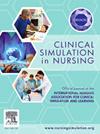虚拟现实模拟的两个重要因素:护理学生的晕机体验和存在感
IF 2.5
3区 医学
Q1 NURSING
引用次数: 0
摘要
随着虚拟现实模拟在护理教育中的应用日益普及,除了学习结果外,还需要更多的研究来检查它们对用户的影响。本研究探讨护生在虚拟实境模拟中对临在感的感知及晕机的体验。方法采用描述性分析研究设计。在2024年3月至7月期间,102名本科护理二年级学生参与了一项以结肠直肠癌术后护理为重点的沉浸式虚拟现实模拟。使用社会人口学特征表、存在问卷和虚拟现实疾病问卷收集数据。变量比较采用学生t检验、Mann-Whitney U检验和Kruskal-Wallis检验。结果研究显示,护理专业的学生有高水平的存在感,只有轻微的晕屏症状。此外,性别和存在感的适应/沉浸子维度,以及视觉问题的存在和晕机的定向障碍子维度之间存在统计学上的显著差异。结论虚拟现实有望成为未来护理教育的主要教学手段,因此,为了最大限度地发挥其潜力,应着重提高存在感和减少晕觉。本文章由计算机程序翻译,如有差异,请以英文原文为准。
Two important factors in virtual reality simulations: Nursing students' experiences of cybersickness and sense of presence
Background
With the increasing popularity of employing virtual reality simulations in nursing education comes the need for more research examining their effects on users besides learning outcomes. This study explored nursing students' perceptions of a sense of presence and experiences of cybersickness in virtual reality simulations.
Method
A descriptive-analytic research design was employed. Between March and July 2024, 102 second-year undergraduate nursing students participated in an immersive virtual reality simulation focused on postoperative colorectal surgery care. Data were collected using the Sociodemographic Characteristics Form, the Presence Questionnaire, and the Virtual Reality Sickness Questionnaire. Student’s t-test, Mann–Whitney U test, and Kruskal–Wallis test were used to compare variables.
Results
The study revealed that nursing students experienced high levels of presence and only slight symptoms of cybersickness. Additionally, a statistically significant difference was observed both between gender and the adaptation/immersion subdimension of sense of presence, and between the presence of vision problems and the disorientation subdimension of cybersickness.
Conclusions
Since virtual reality is anticipated to become the leading teaching method in future nursing education, and therefore to maximize its potential, efforts should focus on increasing the sense of presence and reducing cybersickness.
求助全文
通过发布文献求助,成功后即可免费获取论文全文。
去求助
来源期刊

Clinical Simulation in Nursing
NURSING-
CiteScore
5.50
自引率
15.40%
发文量
107
期刊介绍:
Clinical Simulation in Nursing is an international, peer reviewed journal published online monthly. Clinical Simulation in Nursing is the official journal of the International Nursing Association for Clinical Simulation & Learning (INACSL) and reflects its mission to advance the science of healthcare simulation.
We will review and accept articles from other health provider disciplines, if they are determined to be of interest to our readership. The journal accepts manuscripts meeting one or more of the following criteria:
Research articles and literature reviews (e.g. systematic, scoping, umbrella, integrative, etc.) about simulation
Innovative teaching/learning strategies using simulation
Articles updating guidelines, regulations, and legislative policies that impact simulation
Leadership for simulation
Simulation operations
Clinical and academic uses of simulation.
 求助内容:
求助内容: 应助结果提醒方式:
应助结果提醒方式:


